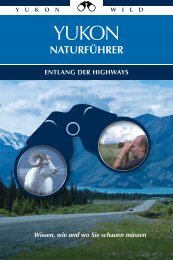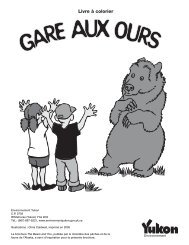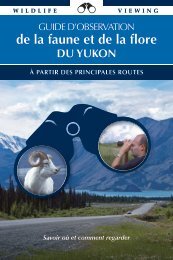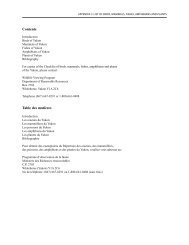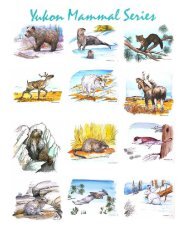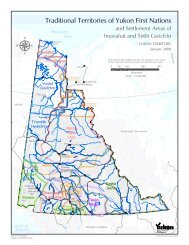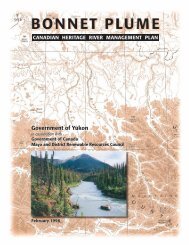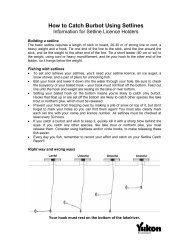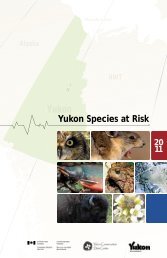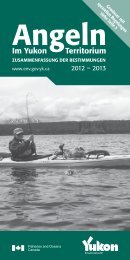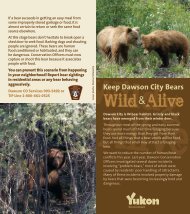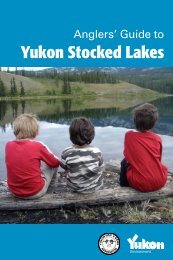Ch. 3 Land - Environment Yukon
Ch. 3 Land - Environment Yukon
Ch. 3 Land - Environment Yukon
Create successful ePaper yourself
Turn your PDF publications into a flip-book with our unique Google optimized e-Paper software.
3.4 Mining<br />
Mining has been an important part of<br />
the <strong>Yukon</strong> economy since the late<br />
1800s. For many <strong>Yukon</strong>ers, mining is<br />
also a lifestyle. Prospecting and placer<br />
mining in particular offer opportunities<br />
to work ‘in the bush’ for at least part of<br />
the year. Mining is also one of the<br />
<strong>Yukon</strong>’s major land uses, as buildings,<br />
access road, exploration and mineral<br />
extraction are all part of the industry.<br />
Some mining activities such as<br />
prospecting and exploration have relatively<br />
little impact on the environment,<br />
whereas advanced exploration and<br />
mining extraction have significantly<br />
transformed the landscape in some<br />
areas. Major effects can be seen in the<br />
placer areas of the Klondike where<br />
large volumes of earth have been<br />
moved. Other effects include road<br />
development and the abandonment of<br />
equipment, infrastructure and camp<br />
refuse at mining and exploration sites.<br />
Over the past 10 to 20 years, many<br />
controversial issues in the <strong>Yukon</strong> have<br />
revolved around mining and<br />
environmental regulation. Mining<br />
related environmental concerns have<br />
been particularly evident over the past<br />
few years because both the Faro and<br />
Mount Nansen mines went into<br />
receivership, creating uncertainty over<br />
the clean up of these sites and the<br />
responsibility. Many <strong>Yukon</strong>ers have<br />
been concerned about the regulatory<br />
regime’s capacity to protect the<br />
environment from certain miningrelated<br />
impacts. They also want the<br />
mining industry to be held accountable<br />
for its effects on the environment. On<br />
the other hand, the mining industry<br />
has raised concerns about the<br />
increased levels and complexities of<br />
regulations and the accompanying<br />
additional expenses and delays.<br />
The enactment of the <strong>Yukon</strong> Quartz<br />
Mining <strong>Land</strong> Use Regulations (MLUR) in<br />
December 1998, was a significant step<br />
forward, ensuring that all mining related<br />
land uses are assessed for potential<br />
environmental effects. <strong>Yukon</strong>-made<br />
legislation is the result of 10 years of<br />
consultation between government and<br />
stakeholders. It is designed to minimize<br />
the environmental effects of<br />
disturbance caused by exploration<br />
activities. All mineral exploration<br />
activities must now comply with<br />
operating conditions, which represent<br />
the minimal performance levels and<br />
conditions for: re-establishing vegetative<br />
mat, erosion control, trenching,<br />
archeological sites and burial grounds,<br />
camp cleanliness, stream crossings,<br />
line cutting, and many more.<br />
Total Surface Percentage of <strong>Yukon</strong><br />
(square kilometers) <strong>Land</strong> Base<br />
Total area of the <strong>Yukon</strong> 483,450 100<br />
Iron and mica claims 340 0.07<br />
Quartz mineral claims 14,052 2.9<br />
(including leases which allow<br />
for prospecting only)<br />
Placer claims (standard, 1,598 0.33<br />
discovery and co-discovery)<br />
Figure 3.8 Amount of <strong>Yukon</strong> <strong>Land</strong> Under Mining Claims 1<br />
(Status as of November, 1998)<br />
Mining projects are now classified into<br />
four categories, from small camps of<br />
prospectors to major operations<br />
involving drilling equipment, road<br />
development and large camps.<br />
Depending on the size and possible<br />
impact of the activity program, such as<br />
trenching, drilling, numbers of persons<br />
in the camp, amount of fuel used and<br />
stored, use of explosives and several<br />
other criteria, an operating plan may<br />
need to be submitted to the Mining<br />
<strong>Land</strong> Use Office. In some cases,<br />
additional mitigation may be necessary<br />
if the operating conditions are judged<br />
insufficient to deal with potential<br />
impacts. A Handbook to Reclamation<br />
Techniques in the <strong>Yukon</strong> has been<br />
developed to assist the mineral industry<br />
and will be updated as industry gains<br />
more experience at implementing the<br />
regulations. Also available from the<br />
DIAND <strong>Environment</strong> Directorate is a<br />
Permit Guide for Projects in the <strong>Yukon</strong><br />
Territory, which outlines the permits<br />
required for various activities; roads,<br />
forestry and mining.<br />
How Mining Affects the <strong>Land</strong><br />
In 1998, 15,990 square kilometers of<br />
land (3.3 per cent of the area of the<br />
<strong>Yukon</strong>) were held by mining claims in<br />
good standing (see Figure 3.8). This<br />
included placer, quartz, iron and mica<br />
claims, though not all staked claims are<br />
being actively explored. This represents<br />
an increase in mining claimed land of<br />
0.8 per cent from the last SOE report<br />
(1994 data). Of these claims, less than<br />
one per cent will have the potential to<br />
support a large mine. Although less<br />
than 0.01 per cent of the <strong>Yukon</strong> is<br />
occupied by active mines, the impact of<br />
mining operations can extend far<br />
beyond the actual footprint of the mine.<br />
Major operations can potentially harm<br />
land, water, and wildlife.<br />
Roads to exploration sites and camps<br />
have contributed to the fragmentation<br />
of large portions of the <strong>Yukon</strong>. Mining<br />
districts with a long history of activity,<br />
C H A P T E R 3 L A N D ❧ 4 3





